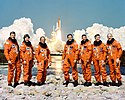STS-42
 | |
| Dane misji | |
| Indeks COSPAR | 1992-002A |
|---|---|
| Zaangażowani | |
| Oznaczenie kodowe | STS-42 |
| Pojazd | |
| Wahadłowiec | |
| Załoga | |
 L-P: Stephen Oswald, Roberta Bondar, Norman Thagard, Ronald Grabe, David Hilmers, Ulf Merbold, William Readdy. | |
| Dowódca | |
| Start | |
| Miejsce startu | |
| Początek misji | 22 stycznia 1992, 14:52:33 UTC |
| Orbita okołoziemska | |
| Apogeum | 307 km |
| Perygeum | 291 km |
| Okres orbitalny | 90,5 min |
| Inklinacja orbity | 57,0° |
| Lądowanie | |
| Miejsce lądowania | |
| Lądowanie | 30 stycznia 1992, 16:07:17 UTC |
| Czas trwania misji | 8 dni, 1 godz, 14 min, 44 sek |
| Przebyta odległość | 5 407 122 km[1] |
| Liczba okrążeń Ziemi | 129[1] |
| Program lotów wahadłowców | |
STS-42 (ang. Space Transportation System) – czternasta misja wahadłowca kosmicznego Discovery i czterdziesta piąta programu lotów wahadłowców[2].
Załoga
źródło dla sekcji[2]
- Ronald Grabe (3)*, dowódca

- Stephen Oswald (1), pilot

- Norman E. Thagard (4), specjalista misji 1

- David Hilmers (4), specjalista misji 3

- William „Bill” Readdy (1), specjalista misji 2

- Roberta L. Bondar (1), specjalista ładunku 1 (CSA)

- Ulf Merbold (2), specjalista ładunku 2 (ESA, Niemcy)

- *(liczba w nawiasie oznacza liczbę lotów odbytych przez każdego z astronautów)
Parametry misji
- Masa:
- startowa orbitera: 110 400 kg
- lądującego orbitera: 98 890 kg
- ładunku: 13 066 kg
- Perygeum: 291 km
- Apogeum: 307 km
- Inklinacja: 57,0°
- Okres orbitalny: 90,5 min
Cel misji
Lot naukowy, w ramach którego przeprowadzono eksperymenty w laboratorium Spacelab IML-1 (International Microgravity Laboratory)[2].
Zobacz też
Przypisy
Linki zewnętrzne
- podsumowanie misji STS-42 na stronach NASA (ang.)
- Mark Wade: STS-42 (ang.). W: Encyclopedia Astronautica [on-line]. [dostęp 2017-07-25].
- Spaceflight mission report: STS-42 (ang.). Space Facts, 2013-09-30. [dostęp 2014-06-03].
Media użyte na tej stronie
The flag of Navassa Island is simply the United States flag. It does not have a "local" flag or "unofficial" flag; it is an uninhabited island. The version with a profile view was based on Flags of the World and as a fictional design has no status warranting a place on any Wiki. It was made up by a random person with no connection to the island, it has never flown on the island, and it has never received any sort of recognition or validation by any authority. The person quoted on that page has no authority to bestow a flag, "unofficial" or otherwise, on the island.
Solid blue (hex #00F [#00F], sRGB 0,0,255 [(0%,0%,100%)]) square.
STS-42 Mission Insignia
Solid blue square
The STS-42 crew portrait includes from left to right: Stephen S. Oswald, pilot; Roberta L. Bondar, payload specialist 1; Norman E. Thagard, mission specialist 1; Ronald J. Grabe, commander; David C. Hilmers, mission specialist 2; Ulf D. Merbold, payload specialist 2 and William F. Readdy, mission specialist 3. Launched aboard the Space Shuttle Discovery on January 22, 1992 at 9:52:33 am (EST), the STS-41 served as the International Microgravity Laboratory-1 (ML-1 ) mission.




